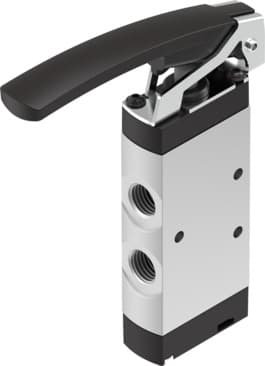Pneumatic Valves & Valve Manifolds on Powermatic Associates

Pneumatic Valves & Valve Manifolds
Valve manifolds and pneumatic valves are essential elements in automated systems, managing the power, speed, and movement direction in pneumatic systems. They control pressure and airflow, guaranteeing efficient functioning in various industries. There are different types of valve manifolds, providing advantages such as streamlined air distribution and saving space. Routine maintenance is crucial for achieving the best performance.
6,286 products available

solenoid valve CPE18-M3H-5/3ES-QS-10 High component density Valve function: 5/3 ...
Quick Quote

solenoid valve CPE18-M3H-5/3E-QS-8 High component density Valve function: 5/3 ex...
Quick Quote

solenoid valve MEH-5/3G-1/8-S-B Midi Pneumatic, with solenoid coil and manual ov...
Quick Quote

solenoid valve MHP1-M1H-3/2G-M3-HC Semi in-line valve for individual and manifol...
Quick Quote

solenoid valve MEBH-5/2-5,0-S-B With solenoid coil and manual override, without ...
Quick Quote

solenoid valve MEH-3/2-1/8-P-B Midi Pneumatic, with solenoid coil and manual ove...
Quick Quote

solenoid valve MEH-5/2-1/8-P-L-B Midi Pneumatic, with solenoid coil and manual o...
Quick Quote

solenoid valve MDH-5/3E-D-3-M12D-C With M12 plug connection. Valve function: 5/3...
Quick Quote

solenoid valve MFH-3-1/4-24-EX Valve function: 3/2 closed, monostable, Type of a...
Quick Quote

solenoid valve MDH-5/2-D-1-FR-M12D-C With M12 plug connection. Valve function: 5...
Quick Quote
| Item | Manufacturer | Price | Stock | Delivery | |
|---|---|---|---|---|---|
 | 170334 solenoid valve CPE18-M3H-5/3ES-QS-10 High component density Valve function: 5/3 ... | Festo | Quick Quote | ||
 | 170327 solenoid valve CPE18-M3H-5/3E-QS-8 High component density Valve function: 5/3 ex... | Festo | Quick Quote | ||
 | 173142 solenoid valve MEH-5/3G-1/8-S-B Midi Pneumatic, with solenoid coil and manual ov... | Festo | Quick Quote | ||
 | 197011 solenoid valve MHP1-M1H-3/2G-M3-HC Semi in-line valve for individual and manifol... | Festo | Quick Quote | ||
 | 173008 solenoid valve MEBH-5/2-5,0-S-B With solenoid coil and manual override, without ... | Festo | Quick Quote | ||
 | 173126 solenoid valve MEH-3/2-1/8-P-B Midi Pneumatic, with solenoid coil and manual ove... | Festo | Quick Quote | ||
 | 173135 solenoid valve MEH-5/2-1/8-P-L-B Midi Pneumatic, with solenoid coil and manual o... | Festo | Quick Quote | ||
 | 540821 solenoid valve MDH-5/3E-D-3-M12D-C With M12 plug connection. Valve function: 5/3... | Festo | Quick Quote | ||
 | 541657 solenoid valve MFH-3-1/4-24-EX Valve function: 3/2 closed, monostable, Type of a... | Festo | Quick Quote | ||
 | 540804 solenoid valve MDH-5/2-D-1-FR-M12D-C With M12 plug connection. Valve function: 5... | Festo | Quick Quote | ||











